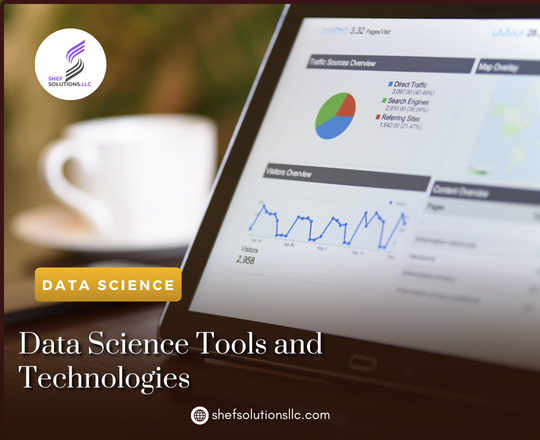Currently Empty: $0.00
Data Science
Data Science Tools and Technologies

In the rapidly evolving world of data science, the array of tools and technologies available to professionals and enthusiasts alike is vast and constantly expanding. These tools are integral to transforming raw data into meaningful insights, driving decision-making, and fostering innovation across industries. In this blog, we’ll explore some of the most prominent data science tools and technologies that are shaping the field today.
Programming Languages
Python
Python is the de facto language for data science, known for its simplicity and versatility. Its extensive library ecosystem, including NumPy, Pandas, and Scikit-learn, makes it a powerhouse for data analysis, machine learning, and statistical modeling.
R
R is another leading language in data science, particularly favored in academia and research. It excels in statistical analysis and visualization, with packages like ggplot2 and dplyr providing robust capabilities for data manipulation and graphical representation.
Data Visualization Tools
Tableau
Tableau is a premier data visualization tool that allows users to create interactive and shareable dashboards. Its user-friendly interface and ability to connect to various data sources make it a popular choice for businesses looking to extract actionable insights from their data.
Power BI
Microsoft’s Power BI is a powerful tool for creating visualizations and business intelligence reports. It integrates seamlessly with other Microsoft products and offers robust data modeling capabilities, making it ideal for enterprise-level data analytics.
Matplotlib and Seaborn
For those who prefer coding, Matplotlib and Seaborn are essential Python libraries for creating static, animated, and interactive visualizations. While Matplotlib provides the foundation, Seaborn builds on it to produce more aesthetically pleasing and informative graphics.
Machine Learning Frameworks
TensorFlow
Developed by Google, TensorFlow is an open-source framework that enables the building and training of machine learning models. Its flexibility and scalability make it suitable for both research and production environments, supporting a wide range of applications from image recognition to natural language processing.
PyTorch
PyTorch, developed by Facebook’s AI Research Lab, is another open-source machine learning framework gaining popularity for its dynamic computation graph and ease of use. It’s widely used in both academia and industry for developing deep learning models.
Scikit-learn
Scikit-learn is a Python library that offers simple and efficient tools for data mining and data analysis. It’s built on NumPy, SciPy, and Matplotlib and is ideal for implementing classical machine learning algorithms like regression, classification, and clustering.
Big Data Technologies
Apache Hadoop
Hadoop is a framework that allows for the distributed processing of large data sets across clusters of computers. It is designed to scale up from a single server to thousands of machines, each offering local computation and storage.
Apache Spark
Spark is an open-source, distributed computing system that provides an interface for programming entire clusters with implicit data parallelism and fault tolerance. It’s much faster than Hadoop due to its in-memory processing capabilities and supports various languages, including Java, Scala, and Python.
NoSQL Databases
NoSQL databases, such as MongoDB, Cassandra, and HBase, are designed to handle large volumes of unstructured data. They offer high scalability and flexibility, making them suitable for real-time web applications and big data analytics.
Data Warehousing Solutions
Amazon Redshift
Amazon Redshift is a fully managed data warehouse service in the cloud. It allows users to run complex queries against large datasets and integrates seamlessly with other AWS services, providing a robust platform for big data analytics.
Google BigQuery
BigQuery is Google’s fully managed, serverless data warehouse that enables super-fast SQL queries using the processing power of Google’s infrastructure. It’s designed to analyze terabytes of data in seconds and scale seamlessly to handle petabytes of data.
Conclusion
The landscape of data science tools and technologies is ever-growing and continually evolving. By leveraging these powerful resources, data scientists can extract meaningful insights from vast amounts of data, driving innovation and informed decision-making across various industries. Whether you are just starting in data science or are a seasoned professional, staying abreast of these tools and technologies is crucial for harnessing the full potential of your data.

